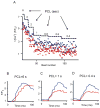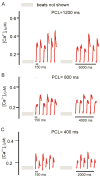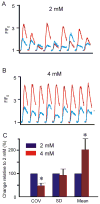Complex and rate-dependent beat-to-beat variations in Ca2+ transients of canine Purkinje cells
- PMID: 21232541
- PMCID: PMC3059096
- DOI: 10.1016/j.yjmcc.2010.12.023
Complex and rate-dependent beat-to-beat variations in Ca2+ transients of canine Purkinje cells
Abstract
Purkinje fibers play an essential role in transmitting electrical impulses through the heart, but they may also serve as triggers for arrhythmias linked to defective intracellular calcium (Ca(2+)) regulation. Although prior studies have extensively characterized spontaneous Ca(2+) release in nondriven Purkinje cells, little attention has been paid to rate-dependent changes in Ca(2+) transients. Therefore we explored the behaviors of Ca(2+) transients at pacing rates ranging from 0.125 to 3 Hz in single canine Purkinje cells loaded with fluo3 and imaged with a confocal microscope. The experiments uncovered the following novel aspects of Ca(2+) regulation in Purkinje cells: 1) the cells exhibit a negative Ca(2+)-frequency relationship (at 2.5 Hz, Ca(2+) transient amplitude was 66 ± 6% smaller than that at 0.125 Hz); 2) sarcoplasmic reticulum (SR) Ca(2+) release occurs as a propagating wave at very low rates but is localized near the cell membrane at higher rates; 3) SR Ca(2+) load declines modestly (10 ± 5%) with an increase in pacing rate from 0.125 Hz to 2.5 Hz; 4) Ca(2+) transients show considerable beat-to-beat variability, with greater variability occurring at higher pacing rates. Analysis of beat-to-beat variability suggests that it can be accounted for by stochastic triggering of local Ca(2+) release events. Consistent with this hypothesis, an increase in triggering probability caused a decrease in the relative variability. These results offer new insight into how Ca(2+) release is normally regulated in Purkinje cells and provide clues regarding how disruptions in this regulation may lead to deleterious consequences such as arrhythmias.
Copyright © 2011 Elsevier Ltd. All rights reserved.
Figures







Similar articles
-
Function of Ca(2+) release channels in Purkinje cells that survive in the infarcted canine heart: a mechanism for triggered Purkinje ectopy.Circ Arrhythm Electrophysiol. 2008 Dec;1(5):387-95. doi: 10.1161/CIRCEP.107.758110. Circ Arrhythm Electrophysiol. 2008. PMID: 19753099 Free PMC article.
-
Nonuniform Ca2+ transients in arrhythmogenic Purkinje cells that survive in the infarcted canine heart.Cardiovasc Res. 2003 Mar;57(3):681-93. doi: 10.1016/s0008-6363(02)00725-3. Cardiovasc Res. 2003. PMID: 12618230 Free PMC article.
-
Calcium-induced release of strontium ions from the sarcoplasmic reticulum of rat cardiac ventricular myocytes.J Physiol. 1997 Nov 1;504 ( Pt 3)(Pt 3):565-78. doi: 10.1111/j.1469-7793.1997.565bd.x. J Physiol. 1997. PMID: 9401965 Free PMC article.
-
Cardiac expression of ryanodine receptor subtype 3; a strategic component in the intracellular Ca2+ release system of Purkinje fibers in large mammalian heart.J Mol Cell Cardiol. 2017 Mar;104:31-42. doi: 10.1016/j.yjmcc.2017.01.011. Epub 2017 Jan 20. J Mol Cell Cardiol. 2017. PMID: 28111173
-
Ryanodine receptor-mediated intracellular calcium release in rat cerebellar Purkinje neurones.J Physiol. 1995 Aug 15;487(1):1-16. doi: 10.1113/jphysiol.1995.sp020857. J Physiol. 1995. PMID: 7473240 Free PMC article.
Cited by
-
Evoked centripetal Ca(2+) mobilization in cardiac Purkinje cells: insight from a model of three Ca(2+) release regions.J Physiol. 2013 Sep 1;591(17):4301-19. doi: 10.1113/jphysiol.2013.253583. Epub 2013 Jul 29. J Physiol. 2013. PMID: 23897231 Free PMC article.
-
Transverse tubular network structures in the genesis of intracellular calcium alternans and triggered activity in cardiac cells.J Mol Cell Cardiol. 2018 Jan;114:288-299. doi: 10.1016/j.yjmcc.2017.12.003. Epub 2017 Dec 5. J Mol Cell Cardiol. 2018. PMID: 29217432 Free PMC article.
-
A model of canine purkinje cell electrophysiology and Ca(2+) cycling: rate dependence, triggered activity, and comparison to ventricular myocytes.Circ Res. 2011 Jun 24;109(1):71-9. doi: 10.1161/CIRCRESAHA.111.246512. Epub 2011 May 12. Circ Res. 2011. PMID: 21566216 Free PMC article.
-
Theoretical study of L-type Ca(2+) current inactivation kinetics during action potential repolarization and early afterdepolarizations.J Physiol. 2012 Sep 15;590(18):4465-81. doi: 10.1113/jphysiol.2012.231886. Epub 2012 May 14. J Physiol. 2012. PMID: 22586219 Free PMC article.
-
Calcium alternans in a couplon network model of ventricular myocytes: role of sarcoplasmic reticulum load.Am J Physiol Heart Circ Physiol. 2012 Aug 1;303(3):H341-52. doi: 10.1152/ajpheart.00302.2012. Epub 2012 Jun 1. Am J Physiol Heart Circ Physiol. 2012. PMID: 22661509 Free PMC article.
References
Publication types
MeSH terms
Substances
Grants and funding
LinkOut - more resources
Full Text Sources
Research Materials
Miscellaneous

